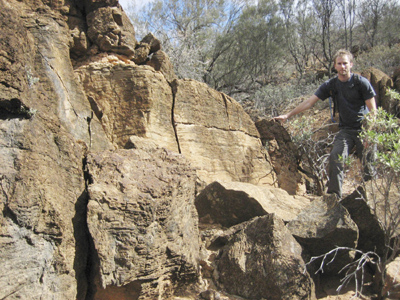Australian scientists in major international discovery. Tectonic movement has pushed ancient history up to the present
In a major international discovery, three Australian scientists have located the upturned remnants of what was once a giant underwater reef – with an escarpment ten times higher than the Great Barrier Reef – in the Northern Flinders Ranges in outback South Australia.

Jonathan Giddings standing on the reef at Flinders Ranges
The scientists are referring to the reef as Oodnaminta Reef, given it is located near an old hut called Oodnaminta Hut. Oodnaminta is a term from the local (Flinders Ranges) Adnyamathanha language group.
The Flinders Ranges are among a very small number of scientific sites worldwide renowned for the window they provide on Earth’s ancient past.
The reef is about 650 million years old and is the only known reef complex of this age anywhere in the world. The next closest aged series of reefs found to-date are around 800 million years old and located in Arctic Canada.
And while they are yet to confirm it scientifically, the scientists – Mr Jonathan Giddings, Associate Professor Malcolm Wallace and Ms Estee Woon from the School of Earth Sciences at the University of Melbourne – believe that peculiar fossils of possible multi-cellular organisms found in the reef could be the earliest examples of primitive animal life discovered to-date.
The reef existed for 5-10 million years during a period of tropical climate squeezed between two major ice age events (the so-called ‘Snowball Earth’ events) where ice was present even at equatorial latitudes.
This extreme climate change from ice age to tropical conditions and back to ice age occurred approximately 750-550 million years ago (hundreds of millions of years before dinosaurs roamed the Earth) and is one of the most tumultuous climatic periods of Earth’s history. It is a particularly intriguing period because it also coincided with the sudden and widespread appearance of very early primitive lifeforms.

Flinders Reef area across the Flinders Ranges SA
This reef is an internationally significant discovery because it provides a significant step forward in showing the extent of climate change in Earth’s past and the evolution of ancient reef complexes – and it also contains fossils which may be of the earliest known primitive animals” Mr Giddings said.
There is a good chance that the new fossils and organisms found in the reef will provide significant insight into the evolution of early multi-cellular life. It could prove that life took more complex forms much earlier in history than we previously thought.
A lot of people will be intrigued as to why this once underwater reef is now located in a very barren part of inland Australia. At this stage in Earth’s history, the eastern coast of Australia extended north from where the Flinders Ranges now lie. The eastern part of the Australian continent, from the Flinders Ranges
through to the current eastern seaboard, was still buried under the ocean.

Jonathon next to the giant reef emerging from the Flinders Ranges
With the movement over millions of years of Australia’s tectonic plates, the reef has now been turned 90 degrees skywards from its once horizontal position (a bit like turning the current Great Barrier Reef on its end). This has exposed the whole 1 kilometre depth of the reef, from what was once its shallow water section right down to its deep water section.
In effect, these tectonic forces have resulted in very ancient history being pushed up to the present. Today’s advances in satellite imagery are also helping us to see the reef easily. Geologists had seen this mass before but had not recognised it as once being a reef.
Associate Professor Wallace said: “The fact that the reef is exposed at ground level makes it very easy for scientists to see what important geological history the reef holds. The section of the reef showing at ground level is around 20 kilometres wide, demonstrating just how big this ancient reef was. This whole section can be driven or walked along, which makes it easy for scientists to travel back through the reef’s 5-10 million year history – in the space of minutes if you are driving.

The giant reef constructed by microbial organisms not previously discovered. (10c piece comparison)
“Our main work now will be to undertake further analysis of the fossils and organisms we have found, to determine just what type and stage of lifeform they represent.”
Coober Pedy Regional Times
Categories: COPLEY/FLINDERS News & Events
